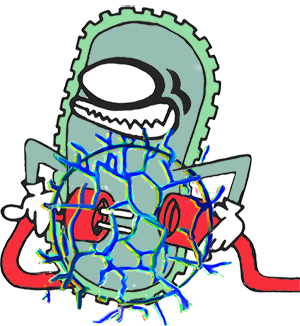Team:TU Delft-Leiden/Modeling/Curli
From 2014.igem.org
| Line 69: | Line 69: | ||
<center> <h3> Contents </h3> </center> | <center> <h3> Contents </h3> </center> | ||
| - | |||
| - | |||
| - | |||
| - | |||
| - | |||
| - | |||
<ul> | <ul> | ||
<li> | <li> | ||
| Line 147: | Line 141: | ||
</ul> | </ul> | ||
| - | |||
| - | |||
| - | |||
</div> | </div> | ||
Revision as of 12:02, 14 October 2014
Curli Module
The goal of our project for the conductive curli module is to produce a biosensor that consists of E. coli that are able to build a conductive biofilm, induced by any promoter, in our case a promoter that gets activated in the presence of DNT/TNT. The biofilm consists of curli containing His-tags that can connect to gold nanoparticles. When the curli density is sufficiently high, a dense network of connected curli fibrils is present around the cells. Further increasing the amount of curli results in a conductive pathway connecting the cells, thereby forming conductive clusters. Increasing the amount of curli even further, sufficiently curli fibrils are present to have a cluster that connects the two electrodes and thus have a conducting system.
The goal of the modeling of the curli module is to prove that our biosensor system works as expected and to capture the dynamics of our system. So, we want to answer the question: "Does a conductive path between the two electrodes arise at a certain point in time and at which time does this happen?" However, we not only want to answer the question if our system works as expected qualitatively, but we also want to make quantitative predictions about the resistivity between the two electrodes of our system in time.
The conductive curli module has different dynamics on different length scales:
- The behavior of the system on the gene level, that is the dynamics of the activation of the promoter and the dynamics of the production of proteins needed for curli growth.
- The behavior of the system on the cell level, that is the curli production of each cell in time.
- The behavior of the system on the colony level, that is the change of the resistivity between the two electrodes of our system in time.
To capture the dynamics of our system, we have implemented a three-layered model, consisting of the gene level layer, the cell level layer and the colony level layer.
At the gene level, we calculate the curli subunits production rates that will be used in the cell level layer. Subsequently, at the cell level, we use these production rates to calculate the curli growth in time, which we will use at the colony level layer. Lastly, the colony level layer is used to determine if our system works as expected, ie. determine if a conductive path between the two electrodes arises at a certain point in time and at which time this happens, and to determine the change of the resistivity between the two electrodes of our system in time. A figure of our three-layered model is displayed below.
Click in the figure to move to the corresponding page.

summary of the conclusions
 "
"






